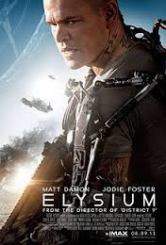Elysium
The curious thing about the soundtrack to Elysium is that it is a debut by Ryan Amon as a film composer. His works consist of trailers and adverts and it is interesting to see how this could affect his film scoring. The soundtrack comprises of 29 tracks over 72 minutes and is a mixed bag of music with tracks being fresh and innovative, others being generic electronics, some being action packed and others seemingly superfluous. It consists of modern and sometimes innovative musical techniques to suit the futuristic setting yet it also contains mind-numbing or overly aggressive sounds which seem to lack a theme to tie them together, which perhaps reflects Amon’s experience in composing excerpts rather than full soundtracks.
The soundtrack opens with Heaven and Earth which introduces the modernity with a strong resemblance to Hans Zimmer by using electronic sounds backed by percussion. This track, although not particularly revolutionary, does set up the final two tracks nicely. The sounds are very similar to the generic electronic music of films like Pacific Rim and Man of Steel and therefore lack originality and personality.
The score alternates between ambient melodies in tracks such as Darkness to aggressively electronic songs. This is necessary though as the action tracks can be quite overpowering and require the slower songs to restore the balance. The slower songs in comparison however can become quite monotonous and almost boring and seem to be included just to give the ears a rest. The Raven, a track towards the end of the score, is a simple, throbbing percussion which does not alternate in tempo or timbre and seems to add no value or meaning to the score. A Political Sickness simply overuses the electronic horn so characteristic to Pacific Rim and Transformers while adopting a fast drum beat to amplify tension. These tracks seem simple and appear to lack any real depth or thought.
Some of the more interesting pieces use techniques to add a bit of texture to the electronic synths however this does not necessarily make them pleasant pieces to listen to. You said you’d do Anything is a track which introduces an electronic throat singing paired with a repetitive three beat drumming. The singing and percussion gives the piece quite an eerie feel while the electronic spin casts the image of a modern civilisation. Breaking a Promise is a track which really stands out, using wordless vocals and slow strings to portray a sense of loss and impending sadness. The voice almost freezes time which builds tension effectively. Elysium follows this track and is a harmonious mix between orchestral and vocals which increase in intensity, concluding the composition with a beautiful yet melancholic atmosphere. For this reason, this track would have served better as the final song however Amon then added New heaven, New earth which re-invites some dramatic stabbing of synths which perhaps rises the action again instead of ending it like a final track should.
On the whole, the Elysium composition does now flow as a stand-alone score and does not make a pleasant listen without the visuals to accompany it. It comprises of such mixed quality that it makes it difficult to judge. The soundtrack contains overpowering, aggressive tracks which are supposed to heighten the action yet they do not develop, making them fade into the background as annoying throbs. Despite being an action film, the slower songs are the strongest. It is evident that Amon has attempted to introduce some techniques to vary the electronics however they are not strong enough to make up for the lack of quality and abundance of simplicity. One major flaw with this soundtrack is the inconsistency – the balance is on both ends of the scale and with no themes, the pieces appear disjointed which perhaps indicates Amon’s experience to crafting short trailers as opposed to lengthy soundtracks. Many of the tracks could be cut out as they add no meaning and make the composition seem all over the place, without thought or revision. The use of electronic synths lacks the personality and originality that perhaps a debut composer needs. The bits that are good are very good however there are not enough of these highlights to make Elysium a successful composition.

